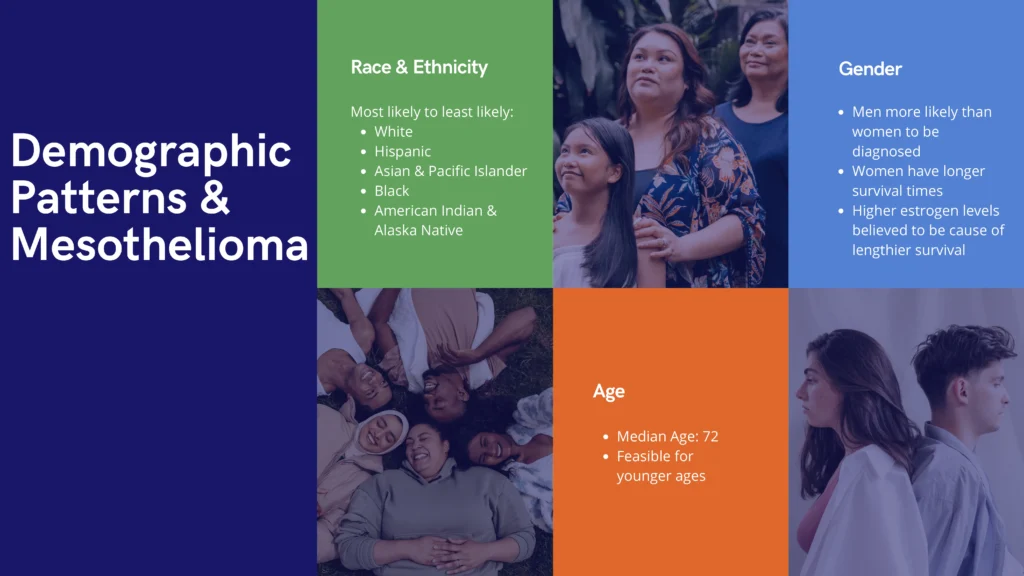In the United States alone, there is an average of 3,000 cases of mesothelioma per year. Mesothelioma is a rare form of cancer that attacks the tissue lining of vital organs. Although mesothelioma impacts individuals of all demographics, there can be trends found in specific areas. It is important to mention that there are other supporting variables to the impacts of the diagnosis such as environmental exposure, occupational exposure, and genetics. These other variables will further impact the prognosis for mesothelioma and treatment options.

Types of Mesothelioma
There are four organs where the mesothelioma can begin, we will describe them from most prevalent to least prevalent.
- Pleural Mesothelioma: Tissue lining the lungs
- Peritoneal Mesothelioma: Tissue lining the abdomen
- Pericardial Mesothelioma: Tissue lining the heart
- Testicular Mesothelioma: Tissue lining the testicles
Age Demographics and Mesothelioma
According to the National Library of Medicine, it has been recognized that the long latency period of mesothelioma creates a median age of 72 years. The latency period is identified to occur within 13-70 years (C. Pérez-Guzmán et al.).While most cases involve patients nearer to this age, is it not impossible for younger individuals to become diagnosed. There was a reported case of a 17-year-old boy with symptoms of “moderate dyspnea, cough, right-sided pleuritic chest pain, fever, and headache” (C. Pérez-Guzmán et al.). He was later diagnosed with pleural mesothelioma. The treatments for this disease additionally vary in age. It appears that younger individuals who are diagnosed with the disease are more likely able to undergo surgery as opposed to patients of older ages.
Gender Demographics and Mesothelioma
Men are historically recognized to have higher rates of diagnoses than women. Occupational exposure is responsible for this occurrence. According to the National Library of Medicine, it can also be recognized that women “were traditionally at risk of exposure to asbestos if their spouses worked…and brought home asbestos on their clothing”(Freudenberger and Shah). Additionally, women have been recognized to have a lengthier survival rate. It is believed that the increased estrogen levels found in female patients aid in the survival time. Alternative variables can include age, histology, and general health.
Race & Ethnicity
White individuals are more likely to be diagnosed with mesothelioma than their counterparts in order: Hispanic, Asian & Pacific Islander, Black, and with little to no diagnosis in American Indian & Alaska Native. In addition to this, Whites are also recognized to have a longer survival rate compared to their Black and Asian & Pacific Islander counterparts. External variables that are believed to impact the lower survival rate and later diagnosis in Black patients are delayed access to treatment and the “lack of insurance amongst this population, or differences in the onset of symptoms” (Freudenberger and Shah).
If you or someone you know has been affected by asbestos exposure or mesothelioma in the state of Pennsylvania, please fill out this form for a free consultation or call 1 (800) 505-6000 for legal help.
Sources:
C. Pérez-Guzmán, et al. “Malignant Pleural Mesothelioma in a 17-Year Old Boy: A Case Report and Literature Review.” Respiratory Medicine Case Reports, vol. 17, Elsevier BV, Jan. 2016, pp. 57–60, https://doi.org/10.1016/j.rmcr.2016.01.005. Accessed 6 Mar. 2024.
“Demographic and Racial Characteristics, and Survival Trends in Pleural Mesothelioma: A Population Based Study.” Journal of Clinical Oncology, 2023, https://ascopubs.org/doi/10.1200/JCO.2023.41.16_suppl.e20543#:~:text=The%20cumulative%20incidence%20of%20mesothelioma,6%25%2C%20and%202%25. Accessed 6 Mar. 2024.
Freudenberger, Devon C., and Rachit D. Shah. “A Narrative Review of the Health Disparities Associated with Malignant Pleural Mesothelioma.” Journal of Thoracic Disease, vol. 13, no. 6, AME Publishing Company, June 2021, pp. 3809–15, https://doi.org/10.21037/jtd-20-3516. Accessed 6 Mar. 2024.
“USCS Data Visualizations.” Cdc.gov, 2024, https://gis.cdc.gov/Cancer/USCS/#/Demographics/ . Accessed 6 Mar. 2024.
